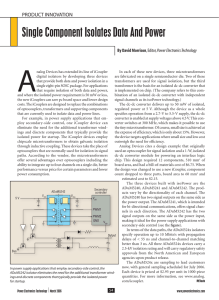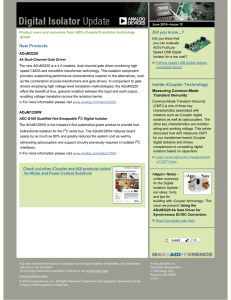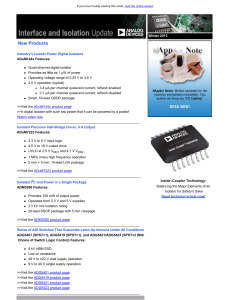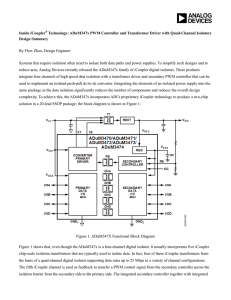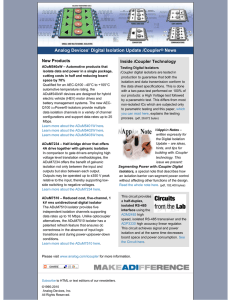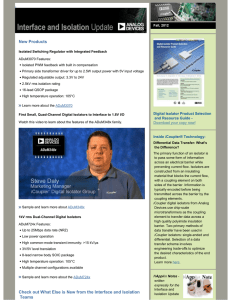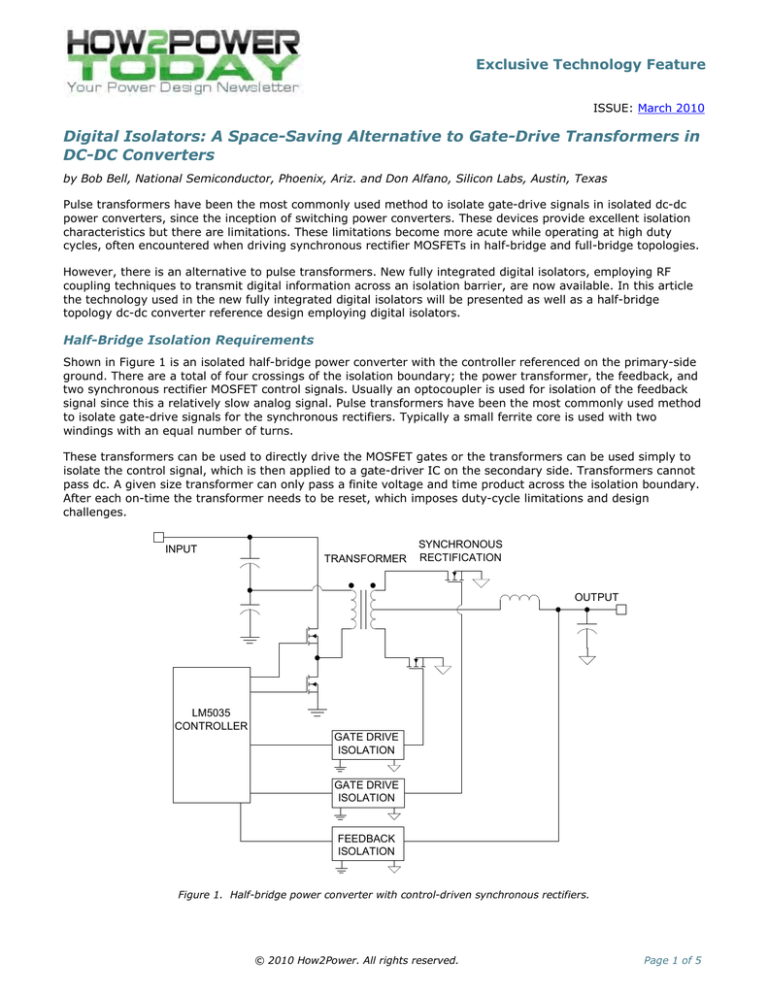
Exclusive Technology Feature
ISSUE: March 2010
Digital Isolators: A Space-Saving Alternative to Gate-Drive Transformers in
DC-DC Converters
by Bob Bell, National Semiconductor, Phoenix, Ariz. and Don Alfano, Silicon Labs, Austin, Texas
Pulse transformers have been the most commonly used method to isolate gate-drive signals in isolated dc-dc
power converters, since the inception of switching power converters. These devices provide excellent isolation
characteristics but there are limitations. These limitations become more acute while operating at high duty
cycles, often encountered when driving synchronous rectifier MOSFETs in half-bridge and full-bridge topologies.
However, there is an alternative to pulse transformers. New fully integrated digital isolators, employing RF
coupling techniques to transmit digital information across an isolation barrier, are now available. In this article
the technology used in the new fully integrated digital isolators will be presented as well as a half-bridge
topology dc-dc converter reference design employing digital isolators.
Half-Bridge Isolation Requirements
Shown in Figure 1 is an isolated half-bridge power converter with the controller referenced on the primary-side
ground. There are a total of four crossings of the isolation boundary; the power transformer, the feedback, and
two synchronous rectifier MOSFET control signals. Usually an optocoupler is used for isolation of the feedback
signal since this a relatively slow analog signal. Pulse transformers have been the most commonly used method
to isolate gate-drive signals for the synchronous rectifiers. Typically a small ferrite core is used with two
windings with an equal number of turns.
These transformers can be used to directly drive the MOSFET gates or the transformers can be used simply to
isolate the control signal, which is then applied to a gate-driver IC on the secondary side. Transformers cannot
pass dc. A given size transformer can only pass a finite voltage and time product across the isolation boundary.
After each on-time the transformer needs to be reset, which imposes duty-cycle limitations and design
challenges.
INPUT
TRANSFORMER
SYNCHRONOUS
RECTIFICATION
OUTPUT
LM5035
CONTROLLER
GATE DRIVE
ISOLATION
GATE DRIVE
ISOLATION
FEEDBACK
ISOLATION
Figure 1. Half-bridge power converter with control-driven synchronous rectifiers.
© 2010 How2Power. All rights reserved.
Page 1 of 5
Exclusive Technology Feature
Shown in Figure 2 is the most basic transformer isolated gate drive. The input is coupled through a dc-blocking
capacitor to reset the core and prevent saturation. Applying a 10-V, 50% duty-cycle drive signal will result in a
dc bias across the blocking capacitor of 5 V. The bias voltage value is: V(drive) x Duty. The secondary-side
amplitude in this example swings from +5 V to -5 V. The negative “off potential” has the advantage of providing
very high noise immunity, but half of the peak “on potential” is lost. This scheme is not very practical for duty
cycles greater than 50%, as the “on potential” continues to decrease with increasing duty cycle.
+5V
-5V
10V
0
Figure 2. Basic transformer-isolated gate drive.
Additionally, care should be taken in applications where the duty cycle can change rapidly (for example, during
load transients), which can result in erratic operation or damage. As the bias across the coupling capacitor is
changing (due to a change in duty cycle) the capacitor can ring with the transformer magnetizing inductance.
This ringing can turn on the MOSFET at unintended time intervals.
Shown in Figure 3 is another transformer-isolated gate drive, often referred to as a “dc-restored” gate drive.
The diode and the secondary-side capacitor restores the dc value of the gate drive and allows operation at
larger duty cycles. This circuit can suffer from the same ringing and possible transformer-saturation problems
described in the basic approach.
+
-
-
+
Figure 3. Transformer-isolated gate drive with dc restore.
There is an additional danger with this circuit when shutting off the power converter (Reference 1). When
shutting off the power converter, the controller output is grounded and the primary-side capacitor is connected
directly across the primary for an indefinite time. The primary magnetizing current can build up, saturating the
transformer. When the transformer saturates, the transformer secondary becomes a short, allowing the
secondary-side capacitor to turn on the synchronous rectifier MOSFET, possibly damaging the power converter.
Small-value coupling capacitors can help reduce this effect.
Generally speaking, with careful design and evaluation, a transformer-isolated gate drive works fairly well for
operation with duty cycles of 50% or less. For applications such as the power converter shown in Figure 1, the
required duty-cycle range of the synchronous rectifiers is well over 50%. For these high duty-cycle applications,
transformer isolation will require the dc-restore technique, which has potential pitfalls, requiring very careful
design and evaluation. Designers of high-performance isolated dc-dc converters are always striving for higher
efficiency and smaller size. A transformer-based isolated gate drive is relatively large, requiring not only the
transformer but also the associated reset components.
The Silicon Laboratories Si8420 low-power, dual-channel digital isolator employs an RF coupler to transmit
digital information across an internal isolation barrier (Reference 2). Using the Silicon Laboratories digital
isolator in the place of pulse transformers eliminates numerous design issues such as duty-cycle limitations and
non-monotonic decay of output during shutdown. Further, it saves board space and power by eliminating pulse
transformers and associated reset components.
© 2010 How2Power. All rights reserved.
Page 2 of 5
Exclusive Technology Feature
Digital Isolator Operation
The operation of the Si8420 is analogous to that of the optocoupler, except an RF carrier is used instead of
light. The Si8420 consists of two identical CMOS die in a standard IC package where each die contains two
transmit/receive circuits and a capacitive isolation barrier (Figure 4).
Si8420 Isolator
ISOLATOR DIE
ISOLATOR DIE
+
+
RECEIVER
TRANSMITTER
-
-
+
+
RECEIVER
TRANSMITTER
-
-
Input Pin
Transmitter Output
Receiver Input
RF ENERGY
RF ENERGY
Output Pin
Figure 4: Si8420 block diagram and transmission protocol.
When wire-bonded together, the two die form an RF transmitter and receiver separated by a differential
isolation barrier. Data is transferred from input to output using on/off keying. Logic 1 on the input pin causes
the transmitter to propagate an RF carrier across the isolation barrier where the receiver asserts logic 1 on the
output pin when sufficient in-band carrier energy is detected. Conversely, logic 0 on the input pin inhibits carrier
transmission, causing the receiver to assert logic 0 on the output pin. This deceptively simple architecture
provides short 10-ns propagation delays, low 8-mW/channel power dissipation, robust operation from 0 to
100% duty cycle, and the reliability and performance of CMOS process technology. CMOS isolators are easy to
apply and require only a 1-μF bypass capacitor between input and output-side power and ground inputs, placed
as close to the package as possible.
Power converter applications can be challenging for any isolation scheme. One area requiring careful attention is
dV/dt susceptibility. To gauge susceptibility, quickly slew the potential from one ground to the other ground to
see if the differential output of the isolator maintains state, during and following the transient. The RF on/off
keying scheme provides best-in-class noise immunity since the desired state information is constantly being
sent and received at a very fast rate.
Electromagnetic susceptibility is another concern. The isolator must maintain the proper state while subjected
to external fields. A 5-V bias is required for both the primary side and the secondary side of the device. Good
decoupling for the bias rails is important. The input threshold is configured for TTL levels, limited to a maximum
of 5 V. Some new controllers, such as National Semiconductor’s LM5035C have control outputs that swing from
0 V to 5 V to enable direct compatibility with digital isolators (Reference 3).
© 2010 How2Power. All rights reserved.
Page 3 of 5
Exclusive Technology Feature
A Design Example
Shown in Figure 5 is the schematic of a half-bridge isolated dc-dc converter codeveloped by National
Semiconductor and Silicon Labs. This reference design features the LM5035C primary-side controller/gate driver
together with the Si8420 dual-channel digital isolator. The LM5035C PWM controller includes integrated 2-A
half-bridge gate drivers and SyncFET outputs that control the secondary-side synchronous rectifier MOSFETs
through the Si8420 digital isolator. Dead-time between the main and synchronous rectifier on/off transitions is
adjustable with a single external resistor.
Figure 5. Half-bridge dc-dc converter schematic (Click here for an enlarged view).
The Si8450 digital isolator requires much less board area than the two gate-drive transformers previously used
in this design. The reference design input range is 36 V to 78 V with 100-V transient capability. The output
voltage is configured for 3.3 V with a power range up to 100 W. The half-bridge topology is well suited for highefficiency, high-density isolated power modules often used in communications infrastructure equipment.
References:
1. “Gate Drive Design Tips” by Ray Ridley, Power Systems Design Europe, Dec 2006.
2. Si8420 Datasheet, Silicon Labs.
3. LM5035C Datasheet, National Semiconductor Corporation.
About the Authors
Robert (Bob) Bell is the applications engineering manager for the National
Semiconductor design center in Phoenix, Ariz. Products designed at the Phoenix
design center include integrated switching regulators, next-generation PWM
power controllers, gate drivers, and hot-swap and load-share controllers. He has
been with National Semiconductor since September 2001. Prior to joining
National, Bob designed power converters for military and space applications. Bob
holds a Bachelor of Science degree in Electronic Engineering from Fairleigh
Dickinson University. To date he has published 25 power design articles, 8
conference papers and 3 patents.
© 2010 How2Power. All rights reserved.
Page 4 of 5
Exclusive Technology Feature
Don Alfano serves as director of power products at Silicon Laboratories. Prior to
Silicon Laboratories, Don was co-founder and vice president of marketing for
Cygnal Integrated Products, which was acquired by Silicon Laboratories in 2003.
Prior to founding Cygnal, he worked for TelCom Semiconductor, an analog and
mixed-signal IC supplier, where he served as director of marketing and director of
applications. Previously, Don served as vice president of marketing for NVE,
Eastern area manager for Dallas Semiconductor and field applications engineer for
Mostek. He has also held design engineering positions for analog and digital control
equipment and telecommunication systems. Don holds a master’s degree in
electrical engineering from Villanova University.
For further reading on isolation, see the How2Power Design Guide and search the Component category and
select the Optocouplers subcategory. In particular, see Bob Bell’s article “Feedback Techniques for Crossing the
Isolation Boundary.”
© 2010 How2Power. All rights reserved.
Page 5 of 5

